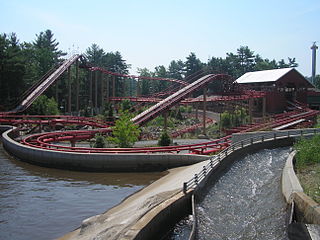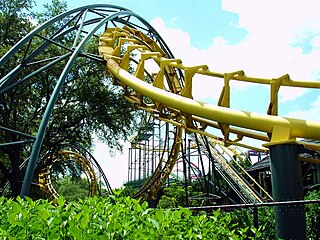
A roller coaster inversion is a roller coaster element in which the track turns riders upside-down and then returns them to an upright position. Early forms of inversions were circular in nature and date back to 1848 on the Centrifugal railway in Paris. These vertical loops produced massive g-force that was often dangerous to riders. As a result, the element eventually became non-existent with the last rides to feature the looping inversions being dismantled during the Great Depression. In 1975, designers from Arrow Development created the corkscrew, reviving interest in the inversion during the modern age of steel roller coasters. Elements have since evolved from simple corkscrews and vertical loops to more complex inversions such as Immelmann loops and cobra rolls. The Smiler at Alton Towers holds the world record for the number of inversions on a roller coaster with 14.

Opryland USA was a theme park in suburban Nashville, Tennessee. It operated seasonally from 1972 to 1997, and for a special Christmas-themed engagement every December from 1993 to 1997. During the late 1980s, nearly 2.5 million people visited the park annually. Billed as the "Home of American Music," Opryland USA featured a large number of musical shows along with typical amusement park rides, such as roller coasters.

Great American Scream Machine was a steel roller coaster located at Six Flags Great Adventure in Jackson Township, New Jersey. The 173-foot-tall (53 m) ride opened in 1989 as the tallest and fastest looping roller coaster in the world, reaching a maximum speed of 68 mph (109 km/h). It was designed by Ron Toomer and manufactured by Arrow Dynamics, which built two other coasters with similar layouts – Shockwave at Six Flags Great America and Viper at Six Flags Magic Mountain. Great American Scream Machine featured seven inversions including a batwing and double corkscrew. Records set by the ride were succeeded by Viper the following year in 1990. It operated until July 2010 and was replaced by a stand-up roller coaster, Green Lantern, in 2011.

Viper is a steel roller coaster located in the Baja Ridge area of Six Flags Magic Mountain in Valencia, California. Viper is the last operating roller coaster with seven inversions to be built by American manufacturer Arrow Dynamics. The other two, Shockwave at Six Flags Great America and the Great American Scream Machine at Six Flags Great Adventure, were demolished in 2002 and 2010, respectively. The roller coaster replaced a HUSS ride type named Condor.

Canyon Blaster is a steel roller coaster located at Six Flags Great Escape and Hurricane Harbor in Queensbury, New York.

Viper is a steel roller coaster located at Six Flags Darien Lake amusement park in Darien, New York, United States. Built by the newly-formed Arrow Huss, the ride opened in 1982 as the first roller coaster in the world to feature five inversions, surpassing Carolina Cyclone at Carowinds which featured four. Viper retained the inversions record until Vortex opened at Kings Island in 1987.

Nighthawk is a steel flying roller coaster from Vekoma located at Carowinds amusement park. The roller coaster is located in the Thunder Road section of the park. The roller coaster originally opened as Stealth at California's Great America on April 1, 2000. In 2003, Paramount Parks decided to relocate the roller coaster to Carowinds. It reopened as Borg Assimilator – the first coaster in the world to be themed to Star Trek – on March 20, 2004. After Cedar Fair purchased Carowinds in 2006, Paramount themes were soon removed from the park, and the ride was renamed Nighthawk. It is one of only two Flying Dutchman models still in existence from Vekoma.

Phantom's Revenge is a steel hypercoaster located at Kennywood amusement park in West Mifflin, Pennsylvania, United States. It originally opened as Steel Phantom in 1991, featuring the fastest speed and longest drop of any roller coaster in the world. Its second drop is longer than its first, which is a unique characteristic among roller coasters. Manufactured by Arrow Dynamics, the ride was later modified and renovated by D.H. Morgan Manufacturing for the 2001 season when it reopened as Phantom's Revenge. The drop and track length were both increased, and its four inversions were removed, allowing the removal of its uncomfortable over-the-shoulder restraints.

Shockwave was a roller coaster manufactured by Arrow Dynamics at Six Flags Great America in Gurnee, Illinois. Standing 170 feet (52 m) tall and reaching speeds of 65 miles per hour (105 km/h), it opened in 1988 as the world's tallest and fastest looping roller coaster with a record-breaking seven inversions: three vertical loops, a boomerang, and two regular corkscrews. Shockwave was closed in 2002 and has been dismantled.

Double Loop was a steel roller coaster located at Geauga Lake amusement park in Bainbridge Township and Aurora, Ohio. Built by Arrow Dynamics, it opened in 1977 as the first roller coaster in the world to feature two consecutive vertical loops. The roller coaster operated until the park closed permanently in 2007, and it was later sold for scrap at an auction a year later.

Python was a steel roller coaster located at Busch Gardens Tampa Bay theme park in Tampa, Florida. Built by Arrow Development and opened on July 1, 1976, it was the first roller coaster at Busch Gardens since the park opened in 1959. The roller coaster was located in the Congo section of the park near Stanley Falls Flume and later the Congo River Rapids. After 30 years of operation, Python closed on October 31, 2006, and was eventually replaced by Jungala, a family section of the park.

Anaconda is a steel roller coaster located at Kings Dominion, in the Jungle X-Pedition section of the park. Built by Arrow Dynamics and designed by Ron Toomer, Anaconda opened in 1991 as the first looping roller coaster to feature an underwater tunnel and the first at Kings Dominion with more than one inversion.

Corkscrew is an Arrow Development prototype Corkscrew roller coaster located at Silverwood Theme Park in Athol, Idaho. Ten exact replicas of this same design were produced 1975–1979 at other scattered parks, followed by numerous other installations around the world featuring updated supports. After being sold as the prototype, this corkscrew originally operated at Knott's Berry Farm from 1975 to 1989. Developed by Ron Toomer of Arrow Dynamics, Corkscrew was the first modern steel inverting roller coaster open to the public, with identical models opening at three other parks days later.

Kong is an inverted roller coaster located at Six Flags Discovery Kingdom amusement park in Vallejo, California. The Suspended Looping Coaster (SLC) model was manufactured by Vekoma and first opened to the public as Hangman at Opryland USA on May 1, 1995. Following Opryland's closure in 1997, the roller coaster was sold to Premier Parks and moved to Six Flags Discovery Kingdom, where it reopened as Kong in May 1998.

Carolina Cyclone is an Arrow Dynamics roller coaster located at Carowinds in Charlotte, North Carolina. The coaster is located in the Carolina Boardwalk area of the park. Built in 1980 by world-renowned coaster manufacturer Arrow Dynamics, it was the first roller coaster to have four inversions, two loops and two corkscrews.
The Wabash Cannonball is an American folk song about a fictional train.

The Illusion is a fully enclosed tubular steel roller coaster, manufactured by Vekoma. It runs on Vekoma's narrow MK-700 track system. Two were built, both in 1989, Chaos in Opryland USA (Tennessee), and Revolution / Mount Mara in Bobbejaanland (Belgium). Only the one in Bobbejaanland is still active.

The Sea Viper was a steel roller coaster at Sea World on the Gold Coast, Queensland, Australia.

















